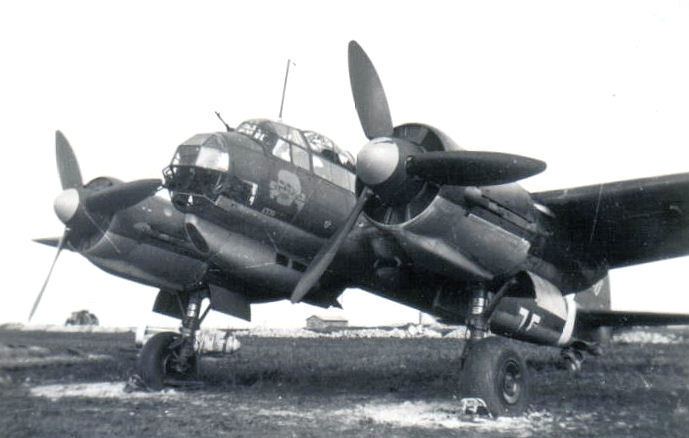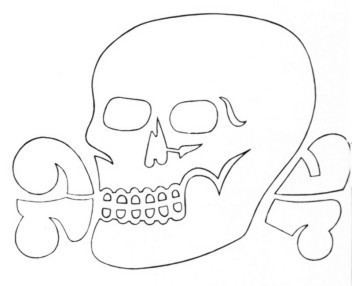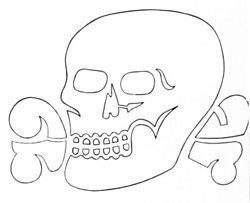Active 1939–1945 Size Air Force Wing | Founded 1939 | |
 | ||
Role Tactical and Direct Ground Support. Similar Kampfgeschwader 51, Kampfgeschwader 76, Kampfgeschwader 55, Kampfgeschwader 53, Kampfgeschwader 3 | ||
Kampfgeschwader 54 "Totenkopf"( [ kampfɡəʃvaːdɐ fiːɐ ʊntfʏnftsɪç ]) (KG 54) was a Luftwaffe bomber wing during World War II. Its units participated on all of the fronts in the European Theatre until it was disbanded in May 1945. It operated two of the major German bomber types; the Heinkel He 111 and the Junkers Ju 88.
Contents
- Operational history
- 19391940
- Battle of Britain
- Invasion of the Soviet Union
- Mediterranean theatre
- The Western front 1944
- Commanding officers
- References

Operational history

Kampfgeschwader 54 was formed on 1 May 1939 at Fritzlar, Germany with Stab./KG 54, II Gruppe and III Gruppe. I Gruppe were not formed until December 1939 near Hoya.
1939–1940

Only 2 Staffel of I Gruppe participated in the 1939 invasion of Poland. The rest of the unit did not participate during the campaign. Instead it was put on standby in western Germany, in case of Allied attack. Among the targets were troop concentrations against Praha on 10 September, and Brest-Litovsk on 15 September. The Staffel was withdrawn on 20 September.

Only II./KG 54 participated in the German invasion of Denmark, and was put under the command of X. Fliegerkorps. The Gruppe targeted rail links at Dombås-Åndalsnes-Vaalebru, Norway, on 23 April. The Gruppe also attacked Dombås railway station on 26 May, and retreating British forces at Namos.
KG 54 began the invasion of France and the Low Countries in 1940 with a strength of 106 He 111s and Ju 88s, with 80 serviceable. KG 54 lost 46 bombers, 130 personnel killed, 10 missing, 60 wounded and 188 as POW (some were later released). KG 54 dropped 409 tons of bombs in 1,200 sorties. KG 54 carried out the bombing operation against Rotterdam on 14 May 1940. The city centre was destroyed. Bombs struck vegetable oil storage tanks causing uncontrollable fires. Some 800 Dutch civilians were killed and 78,000 made homeless.
Battle of Britain
On 11 July IV.(Erg)/KG 54 was created at Lechfeld using some personnel from III./KG 54. Equipped with Ju 88As and He 111Ps the Staffel was renamed 10.(Erg)/54. The unit lost 265 killed, 121 missing, 63 as POWs and 65 wounded as well as 62 aircraft during the operation. I./KG 54 flew 1,189 missions, and lost 27 aircraft and another 27 damaged in July 1940 – May 1941. III./KG 54 lost 9 aircraft, 12 personnel killed, and one wounded (POW figures unknown). It took part in the climax of the air campaign on 15 September 1940, which has become known as the Battle of Britain Day. The day witnessed a series of running, but intense, air battles over London.
KG 54 flew thousands of sorties during The Blitz, hitting targets all over the United Kingdom, including targets as far away as Glasgow, Scotland and Belfast, Northern Ireland in April and May 1941, near the Blitz's conclusion. During its time in France, II./KG 54 also attempted to support the German battleship Bismarck during her Atlantic operation during 26–28 May 1941. However, the unit was unable to intervene before she sank.
Invasion of the Soviet Union
The KG 54 committed 70 aircraft to the initial attack, with 64 serviceable. On 22 June it attacked airfields at Ovruch and Korosten, in support of Army Group South. The unit also struck Soviet tank concentrations at Lubysza and Rawa Ruzka on 23 June, and Tarnopol on 30 June. Throughout July KG 54 supported the advance toward Kiev. Rail tragets at Zhitomir-Kiev, Kazatin-Fastov, Fastov-Kiev, Korosten-Novograd and Korsun between 8 and 13 July. II./KG 54 lost 12 aircraft during July, during the same period I./KG 54 lost 19. II./KG 54 lost 24 bombers and 20 damaged. It lost 39 crew members killed, 37 missing, 2 as POWs and 28 wounded.
II./KG 54, the only unit of the Geschwader to operate on the front after Barbarossa, participated in the Battle of Kharkov (the unit had participated in two of the three battles for the city during the war, in 1941 and 1942) and the Battle of Stalingrad. It reported 32 aircraft losses and 20 damaged, suffered 31 killed, 57 missing and 29 wounded. No personnel were recorded as captured. The Geschwader was withdrawn from Russia on 8 October 1942.
II./KG 54 briefly returned to British skies in 1942. Between 29 July and 14 August 1942 it lost 6 bombers on missions against Bedford, Birmingham, Norwich, Southend, Hastings and Luton. It returned to the Eastern Front on 17 August 1942.
Mediterranean theatre
I./KG 54 supported the Afrika Korps from December 1941 - February 1943. The unit flew missions in North Africa and from bases in Sicily against Malta, and later Allied supply convoys. In December 1942 the Gruppe was down to just 50 percent of its authorised strength. After refitting in Germany, the Gruppe returned to Italy. I./KG 54 then attacked ports along the Allied held coast of North Africa until December. II./KG also operated in North Africa from October 1942 - May 1943. The Gruppe lost 30 machines before its withdrawal. II./KG 54 then continued operating throughout the Italian Campaign, making all out efforts against Allied shipping, with LT 350 torpedoes in the Gulf of Naples. The Gruppe lost 18 Ju 88s during these operations. It is also thought that an unknown number of the Ju 88A medium bombers that attacked in the Air Raid on Bari of December 1, 1943, may have been from KG 54.
The Western front, 1944
I./KG 54 lost 15 aircraft in February–March alone during Steinbock. Operating from bases in northern Germany (Wittmund, Jever, Marx), the Gruppe was rushed to Juvincourt on 6 June 1944, due to the Normandy landings. I./KG 54 operated against the British beachheads, but suffered heavy losses. After just five days, I./KG 54 had lost 13 machines, and II./KG 54 lost a further 10. All Gruppen were withdrawn from the Western Front in September 1944. The Geschwader began to convert to the Messerschmitt Me 262, as KG(J) 54, during this period.
